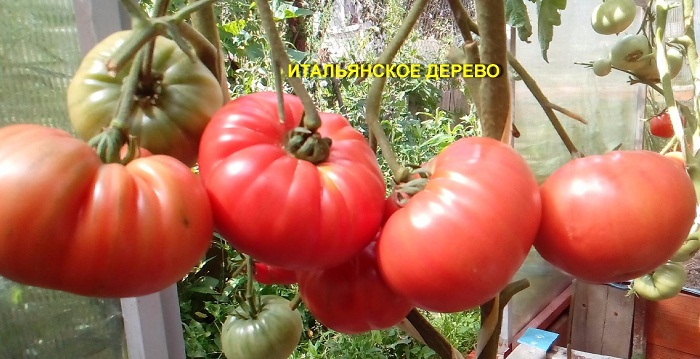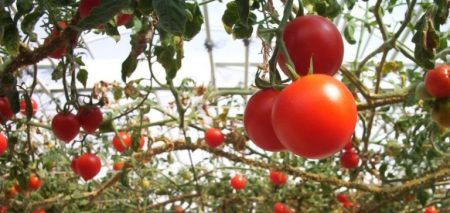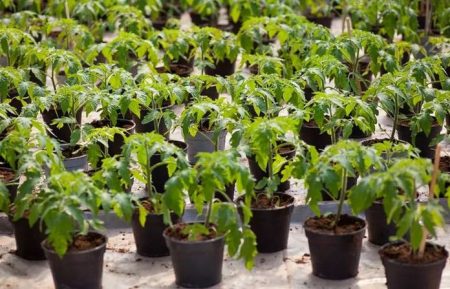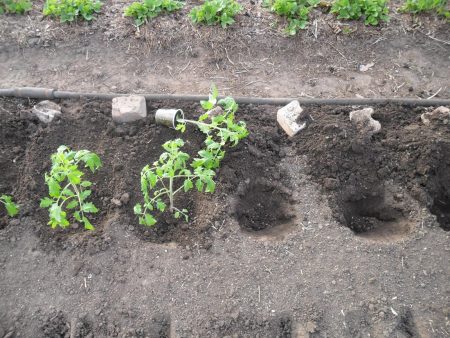 I can’t even believe that until the 18th century, tomatoes were used only as ornamental plants, and the fruits themselves were not consumed, as they were considered poisonous to the human body. But it pleases that now is the 21st century and people are not without such a wholesome and tasty treat.
I can’t even believe that until the 18th century, tomatoes were used only as ornamental plants, and the fruits themselves were not consumed, as they were considered poisonous to the human body. But it pleases that now is the 21st century and people are not without such a wholesome and tasty treat.
Fans of sweet varieties will definitely like the Italian Tree Tomato; in some catalogs it is also called the Italian Tree. In addition, this is a high-yielding variety, so tomatoes can not only be eaten all summer, but also canned for the winter.
Content
Description
It belongs to medium-late varieties, ripe fruits appear already on 110-115 days. Bushes are indeterminate, are not limited in growth, can be up to two meters in height. It is possible to grow this variety throughout Russia, but in regions where climatic conditions are not predictable, planting in greenhouses is recommended.
The stalk is thick powerful, leaves of potato type. The fruits are large, have a flat-round shape, arranged in brushes of 3-5 pieces, when ripened they are painted in raspberry pink. Their weight can be from 250 grams or more. The pulp is dense, sweetish in taste. Tomatoes are suitable for making salads, juices, various sauces and lecho. Whole are not canned, because they simply do not crawl into the neck of the can.
Advantages
- Large fruits.
- Excellent presentation of tomato.
- Good taste.
- High yield varieties.
disadvantages
- The need for garter.
- Removing stepsons.
- In the middle lane, planting in a greenhouse.
Growing seedlings
The quality and yield of a tomato directly depends on the care of even the seeds. First, they are checked for germination to find out which seeds are unsuitable for planting, then they are disinfected in a manganese solution and finally soaked in a growth stimulator.
The soil is also prepared, first sifted through a sieve to get rid of debris and larvae. For disinfection, you can use annealing in the oven or pouring boiling water with the addition of the same manganese. Seeds are sown at a distance of 2 cm from each other, sprinkled with soil mixed with sand on top. After being watered, to create a greenhouse effect, you can cover the containers with future seedlings with a film. After the emergence of seedlings, you need to remove it and water the hatching sprouts
The growth of strong and powerful seedlings will help compliance with the following conditions:
- The daylight hours of plants should be at least 16 hours.
- Comfortable temperature for seedlings during the day + 20-23, at night + 18-20 degrees.
- Providing ventilation, but without drafts.
- Regular watering.
- Nutrient supplementation.
- Timely picking and transplanting into the soil.
- Hardening seedlings before moving to a permanent place.
Transfer
Seedlings are planted in an unheated greenhouse around May, on beds in early June. But it all depends on the weather, the threat of frost should be avoided. The optimal distance between plants is 40-50 centimeters, between rows of 70 cm. Before planting, make holes and pour them with warm water, one using approximately 100 ml. Seedlings are well buried in the ground, while squeezing the roots well with the ground so that they are not bent. After planting, seedlings are watered, the hole is sprinkled with dry soil.
In the future, young plants need to be watered 1-2 times a week, depending on weather conditions, but the topsoil should not dry out. After each watering, it is recommended to loosen the earth.Throughout the growing season, bushes need organic and mineral fertilizers, they need to be fed at least three times during the summer.
In greenhouses, air humidity should be monitored, if it is elevated, bushes can infect fungal diseases, such as late blight or brown rot. For their prevention, the greenhouse should be aired more often and not zealous when watering the plants.
Also, tall bushes need a garter to the support, stakes are dug on the north side 10 cm from the hole, or a trellis is installed. The bush is advised to form in two stems, and every 10 days to remove stepsons.
Harvesting and storage
For long-term storage, tomatoes are removed at the stage of technical maturity, and neatly folded into boxes, it is better to override each layer. Then the fruit crates are cleaned in a dark, cool, well-ventilated place. Observing these conditions, you can enjoy fresh tomatoes before the start of winter.
Conclusion
Providing good regular care for the bushes, in return you can get gratitude in the form of an excellent crop. Everyone will love the “Italian tree”, because its fruits have excellent taste.
https://youtu.be/h8g8P4PYPaY
Reviews
Mark 47 years old
Excellent variety, planted "Italian tree" in the greenhouse and in the beds, it became interesting to conduct an experiment. He formed the bushes in two stems, the crop was excellent, but the tomatoes were a bit larger in the garden. In greenhouse conditions, they ripened in late July, in the open air two weeks later. Tomatoes were not sick, the bushes grew under two meters, the taste of the fruits is simply delicious. I recommend to everyone.
Tonya 55 years
Found in the sister in the bins the seeds of the "Italian tree" she sold the cottage, now she has nowhere to plant. I decided to try to grow a new variety so that the seeds do not disappear, although I am a conservative, I have been planting my favorite varieties for about 10 years, during this time I have not bought other seeds, and there are innumerable ones. I carefully studied all the information on the variety and started sowing work. Seedlings grew strong, transplanted into a greenhouse in May, tomatoes are very large, of which they closed thick and tasty juice for the winter. Now I’m thinking about where to buy seeds for next year.




 Low-growing tomatoes, without pinching: 5 of the most delicious varieties
Low-growing tomatoes, without pinching: 5 of the most delicious varieties Why tomato seedlings grow poorly
Why tomato seedlings grow poorly We grow a tomato in a shell
We grow a tomato in a shell Growing tomatoes without watering according to the method of Kazarin
Growing tomatoes without watering according to the method of Kazarin